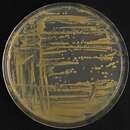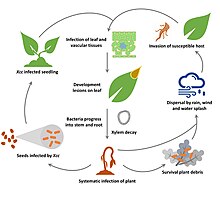en
names in breadcrumbs


Xanthomonas campestris is a gram-negative, obligate aerobic bacterium that is a member of the Xanthomonas genus, which is a group of bacteria that are commonly known for their association with plant disease.[1] The species is considered to be dominant amongst its genus, as it originally had over 140 identified pathovars and has been found to infect both monocotyledonous and dicotyledonous plants of economical value with various plant diseases.[1] This includes "black rot" in cruciferous vegetables, bacterial wilt of turfgrass, bacterial blight, and leaf spot, for example. [2][3][4]
These bacteria are facultative saprophytes, meaning that they are typically parasitic while also having the ability to live on dead or decaying organic matter under the proper conditions. Upon initial infection, the bacteria remain in the epiphytic stage; however, the harmful endophytic stage is reached when the bacteria actually enter the plant host through natural openings.[4] In general, the genes that contribute significantly to the plant-bacteria relationship are the avirulence (avr) genes, the hypersensitivity response and pathogenicity (hrp) genes, and the pathogenicity factors (rpf) genes.[1][2][5] Additionally, the virulence determinants associated with the seedborne diseases that result from this bacterium include extracellular enzymes, polysaccharides, lipopolysaccharides, etc.[2]
Several strains of Xanthomonas campestris also produce an exopolysaccharide called xanthan, making it valuable in the commercial production of xanthan gum, which has important uses in the food, oil, agricultural, and pharmaceutical industries.[6]
There have been over 140 pathovars of Xanthomonas campestris that have been identified, and they are typically named according to the plant that they were first found to infect.[1] However, upon further investigation of genetic relationships, many of these pathovars are now being reclassified as different species within the Xanthomonas genus instead.[1] This leaves six pathovars of Xanthomonas campestris remaining, which includes Xanthomonas campestris pv. abberans, Xanthomonas campestris pv. armoraciae, Xanthomonas campestris pv. barbarreae, Xanthomonas campestris pv. campestris, Xanthomonas campestris pv. incanae, and Xanthomonas campestris pv. raphani.[3]
Further investigation of pathogenicity profiles and multilocus sequencing typing suggests that the list should actually be further narrowed down to just three pathovars with the different symptoms being black rot, leaf spot, and bacterial blight.[3] That said, Xanthomonas campestris pv. campestris is commonly known for causing black rot of crucifers, and Xanthomonas campestris pv. incanae has the ability to impact ornamental brassica plants through bacterial blight. Both of these pathovars are vascular pathogens, and they have been found to invade the plant host through wounds or hydathodes. Alternatively, Xanthomonas campestris pv. campestris also has the ability to infect the plant host through the stomata. Xanthomonas pv. raphani has been found to enter the plant through its stomata to cause infection of the tissue, or rather parenchyma. This results in bacterial spot on a wider range of hosts, which includes both crucifers and certain solanaceous plants.[1][3]
Relationships between Xanthomonas campestris bacteria and plants can be both compatible and incompatible. It is in the compatible relationships, where the bacteria are able to overcome the host's defenses, rather than experience attenuated growth, that disease symptoms will be seen in the plants.[2] This is due to toxins, extracellular enzymes (exported by the type II secretion system), polysaccharides, lipopolysaccharides, a fatty acid-dependent cell-cell communication system, and proteins (secreted by the type III secretion system), for example.[1] The genes in the bacterial genome that are responsible for such interactions include avirulence (avr) and hypersensitivity response and pathogenicity (hrp) genes.[2]
Gene-for-gene patterns control the interactions between the Xanthomonas campestris, a bacterial pathogen, and plants. Avr genes are a group of genes that impact the specificity of the interaction between the bacteria and the plant host. When either these bacterial genes or a plant's resistance genes to the pathogen are not present, the interaction will result in disease. Alternatively, when the genes are present, the plant's resistance genes will produce a product that is able to recognize the avr genes of the bacteria, which allows for the plant host to have resistance.[2] Hrp genes are responsible for the determination of the outcome of the interaction between the plant and bacteria. When mutation occurs within these genes, there is impact on both compatible and incompatible interactions. This is the case because there may be an impact on pathogenicity and hypersensitivity response, respectively.[2] Therefore, the plant's ability to limit the spread of the microbial pathogen may be inhibited.
The regulation of pathogenicity factors (rpf) gene cluster also plays an important role in the plant-bacteria interactions by encoding for a cell-cell signaling system involving diffusible signal factor that is necessary for full virulence. This regulation system is involved in the regulation of both the formation and dispersal of Xanthomonas campestris biofilms, which is specifically related to the rpfB and rpfF genes within the cluster.[1][5] With a mutation in the rpf genes, the synthesis of various extracellular enzymes will be downregulated. This includes endoglucanase, protease, and extracellular polysaccharide (EPS) xanthan, for example, which are important to the virulence of the bacteria.[5]

Like with Xanthomonas species in general, the primary route of transmission for Xanthomonas campestris is through seeds, which act as the source of inoculum.[2][4] Therefore, the bacteria are initially in the epiphytic stage of the infection cycle, which is when they grow on the surface of the plant, such as on the aerial tissues of leaves and fruit. Various adhesion strategies are utilized by the microbes in order to remain attached to the plant surfaces, and this includes bacterial surface polysaccharides, adhesion proteins, and type IV pili.[4] Then, biofilm matrices composed primarily of xanthan will form, which will help the bacteria to survive in the harsh abiotic conditions of the plant surfaces. These biofilms, along with pigments, also help the bacteria to survive the potential damages to DNA and membrane that result from radiation and light. Eventually, the bacteria enter the host tissue through natural openings such as pores and stomata, or wounds, which is hypothesized to be a result of chemotaxis.[4] When this happens, the endophytic stage has been reached and colonization in the vascular system or parenchyma takes place. This is when the development of symptoms, such as lesions of leaves, will occur.[4] Progression into the stem and roots can eventually happen as well, which is when there is systematic infection of the plant. Furthermore, Xanthomonas campestris can be spread to other plants when the population of bacteria has increased enough that they emerge on the plant surfaces again. This dispersal includes both environmental and mechanical routes, such as through wind, rain, people, non-specific vectors, seed dispersal, etc.[4]
Xanthomonas campestris is commonly used industrially to produce a water-soluble exo-polysaccharide, known as xanthan gum, from fermentation of carbon sources like glucose.[6] In this process, a preserved culture of the gram-negative bacterium is expanded through growth and then used as an inoculum in bioreactors with liquid growth media. Under select modes of operation, such as batch fermentation, and proper growth conditions, fermentation then takes place. Therefore, as the microorganism grows, there is production of xanthan, which is secreted from the bacterial cells and ultimately recovered from the media and purified using alcohol precipitation techniques.[6]
This product is particularly applicable to the food industry as a suspending, thickening, and stabilizing agent. However, it also has applications pertaining to the agricultural industry, the oil industry, the pharmaceutical industry, etc.[6] Because of that, work is being done to investigate advancements that can be made to the current xanthan gum production processes.
Xanthomonas campestris is a gram-negative, obligate aerobic bacterium that is a member of the Xanthomonas genus, which is a group of bacteria that are commonly known for their association with plant disease. The species is considered to be dominant amongst its genus, as it originally had over 140 identified pathovars and has been found to infect both monocotyledonous and dicotyledonous plants of economical value with various plant diseases. This includes "black rot" in cruciferous vegetables, bacterial wilt of turfgrass, bacterial blight, and leaf spot, for example.
These bacteria are facultative saprophytes, meaning that they are typically parasitic while also having the ability to live on dead or decaying organic matter under the proper conditions. Upon initial infection, the bacteria remain in the epiphytic stage; however, the harmful endophytic stage is reached when the bacteria actually enter the plant host through natural openings. In general, the genes that contribute significantly to the plant-bacteria relationship are the avirulence (avr) genes, the hypersensitivity response and pathogenicity (hrp) genes, and the pathogenicity factors (rpf) genes. Additionally, the virulence determinants associated with the seedborne diseases that result from this bacterium include extracellular enzymes, polysaccharides, lipopolysaccharides, etc.
Several strains of Xanthomonas campestris also produce an exopolysaccharide called xanthan, making it valuable in the commercial production of xanthan gum, which has important uses in the food, oil, agricultural, and pharmaceutical industries.